[1]
R.P. Lanza, R. Langer, J.P. Vacanti. Principles of tissue engineering. San Diego: Academic Press, (2000).
Google Scholar
[2]
P. Giannoudis, H. Dinopoulos, E. Tsiridis, Bone substitutes: an update, Injury 2005, 36(2005), 20-27.
DOI: 10.1016/j.injury.2005.07.029
Google Scholar
[3]
R. LeGeros, Properties of osteoconductive biomaterials: calcium phosphate, Clin Orthop Relat Res, 395(2002) 81098.
Google Scholar
[4]
H.Y. Cheung, K.T. Lau, T.P. Lu, D. Hui, A critical review on polymer- based bio-engineered materials for scaffold development, Composites Part B 38(2007) 291-300.
DOI: 10.1016/j.compositesb.2006.06.014
Google Scholar
[5]
R.A. Pérez, J.E. Won, J.C. Knowles, H.W. Kim, Naturally and synthetic smart composite biomaterials for tissue regeneration, Adv. Drug Del. Rev. 65 (2013) 471–496.
DOI: 10.1016/j.addr.2012.03.009
Google Scholar
[6]
R.A.A. Muzzarelli, Chitins and chitosans for the repair of wounded skin, nerve, cartilage and bone, Carbohydr. Polym. 83(2011) 1433–1445.
DOI: 10.1016/j.carbpol.2008.11.002
Google Scholar
[7]
A.R. Costa-Pinto, R.L. Reis, N.M. Neves, Scaffolds based bone tissue engineering: the role of chitosan, Tissue Eng Part B Rev., 17(2011) 331-347.
DOI: 10.1089/ten.teb.2010.0704
Google Scholar
[8]
P.B. Malafaya, T.C. Santos, M. van Griensven, R.L. Reis, Morphology, mechanical characterization and in vivo neo-vascularization of chitosan particle aggregated scaffolds architectures, Biomaterials 29(2008), 3914-3926.
DOI: 10.1016/j.biomaterials.2008.06.023
Google Scholar
[9]
S. Fuchs, S. Ghanaati, C. Orth, M. Barbeck, M. Kolbe, A. Hofmann, et al. Contribution of outgrowth endothelial cells from human peripheral blood on in vivo vascularization of bone tissue engineered constructs based on starch polycaprolactone scaffolds. Biomaterials. 30(2009).
DOI: 10.1016/j.biomaterials.2008.09.058
Google Scholar
[10]
P. Dahiya, R. Kamal, Hyaluronic Acid: A Boon in Periodontal Therapy, N Am J Med Sci. 5(2013)309–315.
DOI: 10.4103/1947-2714.112473
Google Scholar
[11]
T. Masuda, Y. Ueno, N. Kitabatake, Sweetness and enzymatic activity of lysozyme. J Agric Food Chem, 49(2001) 4937–4941.
DOI: 10.1021/jf010404q
Google Scholar
[12]
A. Spencer, A. Ludmilla, S. Morozov-Roche, N. Wim, Expression, purification, and characterization of the recombinant calciumbinding equine lysozyme secreted by the filamentous fungus Aspergillus niger: Comparison with the production of hen and human lysozymes. Protein Exp Purif, 16(1999).
DOI: 10.1006/prep.1999.1036
Google Scholar
[13]
A. Denuzière, D. Ferrier, A. Domard, Interactions between chitosan and glycosaminoglycans (chondroitin sulfate and hyaluronic acid): physicochemical and biological studies, Ann Pharm Fr., 58(2000)47-53.
Google Scholar
[14]
J. Klinkaewnarong, E.S.S. Maensiri, Nanocrystalline hydroxyapatite powders by a chitosan–polymer complex solution route: Synthesis and characterization, Solid State Sci, 11(2009) 1023–1027.
DOI: 10.1016/j.solidstatesciences.2009.02.003
Google Scholar
[15]
C.E. Tanase, M.I. Popa, L. Verestiuc, Biomimetic bone scaffolds based on chitosan and calcium phosphates, Mater Lett., 65(2011) 1681–1683.
DOI: 10.1016/j.matlet.2011.02.077
Google Scholar
[16]
J.H. Park, R. Olivares-Navarrete, C.E. Wasilewski, B.D. Boyan, R. Tannenbaum, Z. Schwartz, Use of polyelectrolyte thin films to modulate Osteoblast response to microstructured titanium surfaces, Biomaterials. 33( 2012) 5267–5277.
DOI: 10.1016/j.biomaterials.2012.03.074
Google Scholar
[17]
T. Freier, H.S. Koh, K. Kazazian, M.S. Shoichet. Controlling cell adhesion and degradation of chitosan films by N-acetylation. Biomaterials, 26(2005) 5872–5878.
DOI: 10.1016/j.biomaterials.2005.02.033
Google Scholar
[18]
Y.C. Hsiao, C.N. Chen, Y.T. Chen, T.L. Yang. Controlling branching structure formation of the salivary gland by the degree of chitosan deacetylation, Acta Biomater. 9(2013) 8214-8223.
DOI: 10.1016/j.actbio.2013.06.002
Google Scholar


